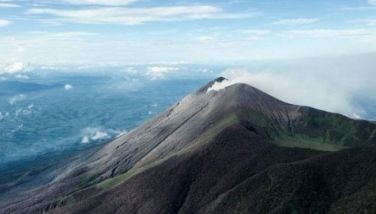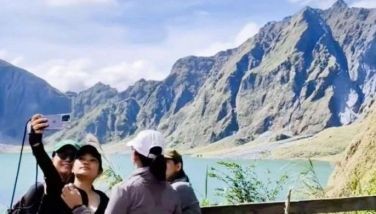Novo Vizcayanons to hold ‘people’s mining summit’
June 19, 2005 | 12:00am
BAYOMBONG, Nueva Vizcaya — A Church-backed alliance of non-government organizations here and representatives of a foreign mining company are scheduled to meet here tomorrow with barangay and tribal leaders, an event that would determine the fate of the mining industry in this mineral-rich landlocked province.
The activity, dubbed the "People’s Mining Summit," the first to be organized and probably the biggest mining gathering here, will take place in the mountain town of Kasibu, the site of the controversial multibillion-peso gold and copper project of the Australian firm Climax Arimco Mining Corp. (CAMC).
Sister Eden Orlino, director of the Catholic Church-led Social Action Commission of the Diocese of Bayombong, said the summit, to be held at the Kasibu public market, will not be a "clash" between those favoring the CAMC’s exploration and those against it.
The summit, she said, "aims to clarify present issues and concerns about mining and its effects on local communities" so the local governments concerned can come up with a clear and better position and legislative policy regarding mining in their respective areas.
Tribal leaders and officials from Kasibu’s 30 barangays were invited to the one-day summit.
"Whatever the outcome or result of the summit would basically be in aid of legislation for the Sangguniang Bayan (municipal council) of Kasibu," said Merlinda Calubaquib, provincial manager of the Philippine Rural Reconstruction Movement (PRRM).
Aside from the Social Action Commission, the Kasibu municipal government and the PRRM, the other groups behind the summit are the Alliance of Community Development Advocates, Didipio Earth Savers Movement Association, Kasibu Inter-tribal Response Toward Ecological Development, Upland Non-Government Organization Assistance Committee, Task Force Detainees of the Philippines, Tribal Association for Rural Development, and Kasibu Lower Muta Valley Farmers Federation.
To secure its full-operation permit, CAMC has to obtain two of the three required endorsements from the Didipio barangay council, Kasibu municipal council and the Nueva Vizcaya provincial board.
Former Environment and Natural Resources Secretary Heherson Alvarez suspended CAMC’s exploration permit in 2000 in the wake of strong opposition from the Catholic Church and local groups.
The CAMC was granted a financial technical assistance agreement (FTAA) by the Ramos administration in 1994, a year before the enactment of the Philippine Mining Act.
The FTAA covered 37,000 hectares in Didipio, which is also partly being claimed by Quirino province. Last year, the area was reduced to 21,465 hectares.
The CAMC’s present environmental compliance certificate covers 325 hectares of mining impact zone, the bulk of which is in Didipio and the rest in Barangay Dingasan in Cabarroguis, Quirino.
Dominated by tribal communities, Didipio is some 70 kilometers from this capital town. Based on estimates, Nueva Vizcaya could generate at least P10 billion from the proceeds of the gold and copper deposits which the CAMC could extract in 10 to 15 years.
The activity, dubbed the "People’s Mining Summit," the first to be organized and probably the biggest mining gathering here, will take place in the mountain town of Kasibu, the site of the controversial multibillion-peso gold and copper project of the Australian firm Climax Arimco Mining Corp. (CAMC).
Sister Eden Orlino, director of the Catholic Church-led Social Action Commission of the Diocese of Bayombong, said the summit, to be held at the Kasibu public market, will not be a "clash" between those favoring the CAMC’s exploration and those against it.
The summit, she said, "aims to clarify present issues and concerns about mining and its effects on local communities" so the local governments concerned can come up with a clear and better position and legislative policy regarding mining in their respective areas.
Tribal leaders and officials from Kasibu’s 30 barangays were invited to the one-day summit.
"Whatever the outcome or result of the summit would basically be in aid of legislation for the Sangguniang Bayan (municipal council) of Kasibu," said Merlinda Calubaquib, provincial manager of the Philippine Rural Reconstruction Movement (PRRM).
Aside from the Social Action Commission, the Kasibu municipal government and the PRRM, the other groups behind the summit are the Alliance of Community Development Advocates, Didipio Earth Savers Movement Association, Kasibu Inter-tribal Response Toward Ecological Development, Upland Non-Government Organization Assistance Committee, Task Force Detainees of the Philippines, Tribal Association for Rural Development, and Kasibu Lower Muta Valley Farmers Federation.
To secure its full-operation permit, CAMC has to obtain two of the three required endorsements from the Didipio barangay council, Kasibu municipal council and the Nueva Vizcaya provincial board.
Former Environment and Natural Resources Secretary Heherson Alvarez suspended CAMC’s exploration permit in 2000 in the wake of strong opposition from the Catholic Church and local groups.
The CAMC was granted a financial technical assistance agreement (FTAA) by the Ramos administration in 1994, a year before the enactment of the Philippine Mining Act.
The FTAA covered 37,000 hectares in Didipio, which is also partly being claimed by Quirino province. Last year, the area was reduced to 21,465 hectares.
The CAMC’s present environmental compliance certificate covers 325 hectares of mining impact zone, the bulk of which is in Didipio and the rest in Barangay Dingasan in Cabarroguis, Quirino.
Dominated by tribal communities, Didipio is some 70 kilometers from this capital town. Based on estimates, Nueva Vizcaya could generate at least P10 billion from the proceeds of the gold and copper deposits which the CAMC could extract in 10 to 15 years.
BrandSpace Articles
<
>
- Latest
- Trending
Trending
Latest
Trending
Latest
Recommended
January 21, 2025 - 12:00am
January 18, 2025 - 12:00am


























